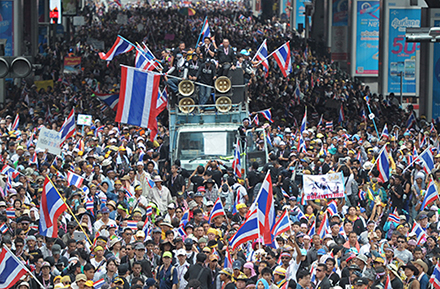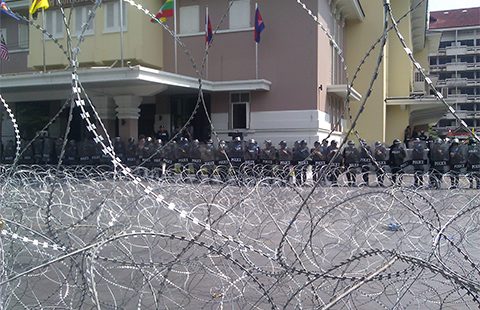
The insidious creep of fascism in contemporary Thailand.
Tim Frewer’s New Mandala article from March 2015, “Fascist Assemblages in Cambodia and Myanmar”, is an interesting Deleuze and Guattari inspired piece on Thailand’s neighbours. Yet, no mention of the situation in Thailand is made.
Most academics and commentators are reluctant to use the descriptive term “fascism” for Thailand under military dictatorship and its authoritarian ultra-nationalist ideology. Labels are often misleading and ambiguous, especially a term that carries such emotive historical context.
The lack of democracy in Thailand, the repression by state apparatuses (under a compact among civil and military elites) and the annihilation of opposition to authoritarian rule, the use of an ultra-nationalist discourse, and the de facto support by royalist elites for its parastatal armed forces (from pro-palace sanctioned thugs such as the garbage collection organisation to the People’s Democratic Reform Committee, or PDRC) have eerie resonances with aspects of the early 20th century Spanish fascists known as Falange Española Tradicionalista or falangistas.
Falangism is taken from the name of the right-wing Spanish movement that imitated elements of pre-war German and Italian fascism under the leadership of José Antonio Primo de Rivera. The movement was opposed the Republicans and supported General Franco’s Nationalist coup of 1936, but only as a minor element. It momentarily reappeared later in European history in the post-war years until the mid-1970s.
As self-exiled pro-democracy leader Surachai “Sae Dan” Danwattananusorn told me in 2011, while fascism may be seen as a defining historical moment, we are now seeing new forms in a desperate push by the ruling elites/aristocracy (amaat) to hold back democracy for their own interests, whatever the social, economic, and political cost to the nation.
For instance we can hark back to Field Marshal Sarit Thanarat’s 1958 coup d’état, supported by the royalist/amaat regime wanting to regain its influence and power through the monarchy. Nothing has changed since then, only intensified as we near the end of the ninth reign. Nothing it seems is above personal interests and power under an authoritarian national leadership inspired by notions of an organic, hierarchical regal state.
Yet, Thais do not have a word for fascist or fascism.
Instead, Thai uses (though rarely) the foreign loan word latthi-fasit. Historian and expert on European fascism Stanley Payne sees this ideology as “a form of revolutionary ultranationalism for national rebirth…” structured on “extreme elitism” and mass mobilisation in a “vitalist” philosophy that does not shirk at the notion of violence, intimidation and a repertoire of coercive tactics to achieve its ends. (See A short history of fascism, 1914-45, p 14.)
Prayuth Chan-ocha, the new Thai Fuhrerprinzip, was enforced through absolute idiosyncratic authority and emplaced by the amaat in 2014 for their own ends. Indeed, the political climate under authoritarianism in Thailand masked by a perverse nationalist democratic rhetoric (Thai democracy?) is characterised by extreme ethnic chauvinism, embellished monarchical patriotism, and an ultra-nationalism articulated (poorly at that) from the likes of orchestrated street movements such as People’s Alliance for Democracy or the PDRC.
The similarities between falangism and the current Thai experience are a less ideological (“softer”) but no less insidious form of contemporary fascism. Examples are plentiful, including:
- an internal organic corporatism;
- ethnic (Thai)-based ultra-nationalism;
- conservative anti-democratic trade unionism;
- conservative modes of state Buddhism (through elements in the administrative royalist line of the Thammayut nikai that frowns on democratic state sangha governance);
- a dislike for separatism of any kind; anti-communism, anti-anarchism, and anti-(new) capitalism (where this is seen as working outside amaat networks);
- anti-democratic sentiments and control of all media, emplaced through editorial committees with royalist lackeys);
- paternalistic pastoral values (communal ethnic-Thai’ism and the hypocrisy inscribed in elite visions of the poor in a discourse of “self -sufficiency”);
- dislike of welfare-based neo-liberal economic (efficient) management (as in the case of Thaksin’s neo-liberal Populist government);
- and as a union of non-competitive, traditional conservative units seeking to maintain their monopolies and ensuing privilege through nationalist syndicated consensus.

In addition, the link between the palace network and its vast financial interests and the many large national/global Thai corporations such as the Charoen Pokphand Group, Thai Beverage, and so on is self-evident. Many of these Falangist corporations provided financial support to the anti-democratic street movements leading up to the last two coups (PAD and then PDRC).
Indeed, another characteristic of the Thai falange also includes the agencies of state security and forms of para-militarism such as the ideological arm of the summit-state, the Yellow Shirts (and its pink and blue variants in the past decade). These share similarities with the European Falangist Blue Shirt street brigade.
This complex social and political arrangement in Thailand is controlled by an alliance of central bureaucratic elites, political representatives of the middle class, reactionary (pro-Prem Tinsulanond) elements in civil society, traditional network mafias, and ultra-conservative military factions with close ties to the royalist establishment.
The Thai amaat are opportunistic; every time a new structure of governance was put in place (three times since 2006) they ruthlessly crushed it using a complicit media and propaganda campaign with the use of street thugs to create destabilisation.
The synchronisation and multi-layered scheming for the last two coups involving so many elements of the monarchy network was impressive, if immoral and unscrupulous. The real fear among Thai falange is an election in which they have no control of the outcome and a real democracy which is engendered at the grass-roots.
In summary, the immense power of persisting propaganda and control of information in the hands of extreme right-wing pro-monarchists has been particularly worrying.
They generated and maintained a well-orchestrated vilification of Thaksin, Thailand’s first popularly elected prime minister; in fact they could have been saying “Thaksin is Jewish!” The hatred created and perpetuated is the same as in pre-war fascist Europe.
Fascists need to vilify in order to mobilise their support, particularly among the petty bourgeoisie and urban middle classes. The control of information, censorship and the immense reach of the monarchy network into all layers of society (like a computer virus or worm) have been factors in regulating society and the economy under new fascism.
There is no middle ground remaining in Thailand, no platform for dialogue or impartiality. Following the fascist dictate, the Thai regime created disorder on the streets and insecurity before every coup in order to recreate a semblance of their own constructed and self-interested order.
The radical royalists, including the military, established a compact with corrupt social elements – the Rajabhakti Park scandal is the tip of iceberg — all the while using Article 112 (the infamous lese majeste law) to silence and intimidate opposition.
If all of this is not new fascism in Thailand, then what other name?
Dr James L Taylor is an Adjunct Associate Professor in Anthropology & Development Studies at the University of Adelaide.
 Facebook
Facebook  Twitter
Twitter  Soundcloud
Soundcloud  Youtube
Youtube  Rss
Rss 